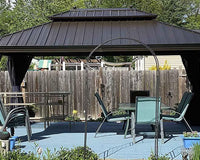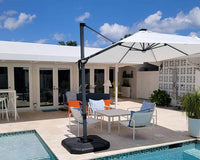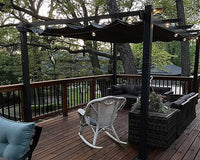If you are designing outdoor spaces, the right choice of outdoor umbrella will not only offer protection from the sun but also create ambiance. Perhaps you're going to consider the classic market umbrella with its timeless appeal and a dash of no-nonsense utility compared to the modernist cantilever umbrella, which comes with a unique side-post design offering yet another path of varied shading solutions. Whether you are to opt for what's best in a cozy backyard or a busy café's terrace, this article will discuss the features, benefits, and considerations of both market umbrellas and cantilever umbrellas, guiding you through these nuances to make the perfect choice for your sunny retreats.
Quick Comparison
|
Feature/Aspect |
Market Umbrella |
Cantilever Umbrella |
|
Design |
Traditional umbrella design with a central pole that goes through a table or stands alone on a base. |
Features an arched or jointed pole positioned to one side, with the canopy hanging from it. |
|
Pole Position |
Central-The pole is located in the center of the umbrella canopy. |
Offset-The supporting pole is situated outside the canopy area, to one side. |
|
Space Utilization |
Requires a hole in the table for support (if used with a table), which can obstruct views and space. |
Provides unobstructed space beneath the canopy-ideal for arranging furniture without a central pole. |
|
Shade Area |
Generally provides shade directly beneath and around the canopy. |
Offers versatile shade options; can rotate and tilt to block sun from various angles. |
|
Mobility & Flexibility |
Less mobile due to the central pole; may have tilt features for adjustable shading. |
Comes with rotating features for 360-degree movement; more flexible. |
|
Size Options |
Usually smaller than cantilever umbrellas. |
Usually larger due to its sturdy offset design. |
|
Stability |
Stable when placed in a heavy base or through a table, require weights on windy days. |
Requires a heavier base for stability. |
|
Ease of Use |
Simple mechanism to open and close, typically using a crank or push system. |
May require more effort to operate due to the complexity of the cantilever mechanism. |
|
Cost |
Generally less expensive due to simpler design and construction. |
Typically more expensive because of the additional mechanics and materials used. |
|
Aesthetics |
Classic look that fits traditional and contemporary settings. |
Modern and sleek appearance; can add a touch of elegance and sophistication to any space. |
|
Usage |
In residential & commercial settings. |
In spacious outdoor areas. |
Basics of Market Umbrellas&Cantilever Umbrellas
Before you do anything else, you should know what market umbrellas and cantilever umbrellas are. This includes their basic designs and typical applications, which can help you make a better decision when the time to choose comes.
What Are Market Umbrellas?
Market umbrellas are the standard outdoor umbrellas that you have probably come across at cafes, in residential backyards, or even in open-air markets. More often than not, they are kept straight with a central pole, which normally fits into a table or supports itself from a base. The canopy of a market umbrella is usually round or octagonal and is made to protect one directly from the overhead sun. In terms of material, it ranges from wooden ones, giving a classic feel, to light, durable aluminum and steel poles. Most people go for market umbrellas because they are relatively portable, easy to operate, and readily fit into small spaces.

What Are Cantilever Umbrellas?
Cantilever umbrellas are those where the pole is offset to one side, with the umbrella being cantilevered past, which leaves open space on the ground below it that may be occupied by a table, chairs, or any other kind of furniture. This design offers shade adjustability: most models can be rotated and tilted throughout the day to block out the sun as it moves across the sky. Cantilever umbrellas work beautifully to cover expansive areas, like sectionals or poolside chaise loungers. They are wide, heavy-duty constructions, generally reinforced with materials such as aluminum, mounted onto a base that needs weight added to it to provide enough counterbalance for the overhanging canopy. Although these can be a bit more work to set up initially, their versatility and coverage are unrivaled.

Detailed Considerations Between Cantilever Umbrellas and Market Umbrellas
When you're outfitting your outdoor space, the choice between a cantilever and a market umbrella goes beyond just style preference-it's about functionality, space usage, durability, and overall satisfaction.
1. Environmental Compatibility
- Wind Resistance: Consider the typical wind conditions in your area. Market umbrellas, with their lower profiles and central poles, may offer greater stability and less wind resistance. In contrast, cantilever umbrellas require a hefty base and careful positioning to withstand strong winds due to their design, which can catch the wind like a sail.
- Sun Positioning: The sun doesn't stay put, and your shading needs will change throughout the day. Cantilever umbrellas provide a dynamic solution with their ability to tilt and rotate, offering superior protection as the sun moves across the sky. Market umbrellas might not offer the same level of adjustability, which could leave certain areas exposed at different times of the day.
2. Space Configuration and Usage
- Area Dimensions: Measure your space carefully. A cantilever umbrella typically requires more room due to its larger canopy and offset pole, but it can shade a broad area without obstruction. Market umbrellas, being more compact, can fit snugly over smaller patios or balconies and within tight configurations.
- Furniture Layout: Examine how your furniture is set up or plan to be arranged. If you have a central dining table with an umbrella hole, a market umbrella is naturally suited for this setup. For lounge areas without a central table, or where flexible day-to-day rearrangement is preferred, a cantilever umbrella would be more appropriate.
3. Longevity and Maintenance Requirements
- Construction Durability: While both types withstand natural elements, the robust construction of cantilever umbrellas often includes mechanisms for movement that can be more susceptible to wear and tear over time. In contrast, the simpler build of market umbrellas may have fewer moving parts but still require quality joints and finishes to ensure longevity.
- Fabric Resilience: Both umbrellas offer options for UV-resistant and water-repellent fabrics; however, the larger surface area of cantilever umbrellas might mean more exposure to the elements and potential for damage. Assess the quality of the canopy material and its resistance to fading and degradation.
- Maintenance Ease: Each umbrella style has its specific care guidelines. Cantilever umbrellas typically require regular maintenance checks for their mechanical parts, whereas market umbrellas often demand attention primarily for their fabric and immediate fixtures.
- Parts Replacement: It's worth noting that market umbrellas tend to have more universal replacement options available on the market, potentially making them easier to repair, whereas cantilever umbrellas may need specialized parts due to their unique designs.
4. Aesthetic Preferences and Impact
- Visual Harmony: Your outdoor space is an extension of your home's aesthetic. Market umbrellas tend to blend seamlessly with traditional decor, adding a touch of timeless elegance. In contrast, cantilever umbrellas make a modern statement and can transform the ambiance of a space with their sleek profiles.
- Color and Design Variety: With both types of umbrellas, there is a vast selection of colors and patterns available. Think about how the color will interact with your existing outdoor palette. Do you prefer something that stands out as a focal point, or a shade that integrates subtly into your overall design scheme?
5. Features and Functionalities
- Ease of Operation: How easy is it to open, close, and adjust the umbrella? Market umbrellas often utilize a straightforward crank or pulley system. Cantilever umbrellas, while more complex due to their range of motion, usually also operate with a crank system, but the initial setup might be more involved.
- Additional Features: Modern umbrellas may come with convenient add-ons such as solar-powered LED lights, detachable mosquito nets, or even Bluetooth speakers. Decide which features align with your lifestyle and whether they justify any additional cost.

Getting the Right Umbrella for Your Space
It all depends on your space, functionality, and design needs when deciding between a market umbrella and a cantilever umbrella. On the other hand, market umbrellas offer simplicity, versatility, and classic appeal for small areas or a centerpiece of an alfresco dining setting. Cantilever umbrellas will give extended shade that can be nicely adjusted, making them perfect for larger square footage areas with flexible furniture arrangements. Each has its benefits in durability, usability, and maintenance, so balance these features according to your local environment, personal style, and practical needs. Whether you want elegant integration into a traditional setting or dynamic functionality for expansive lounging, the right umbrella can drastically improve your outdoor living experience.




